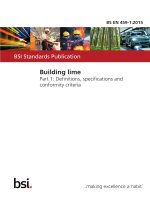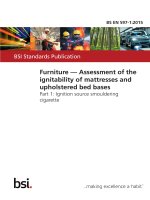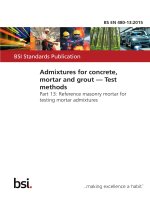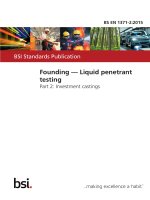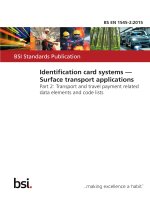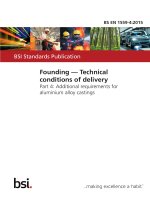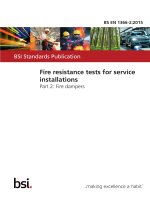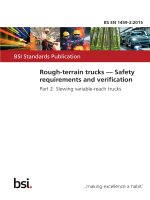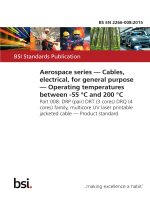Bsi bs en 61788 21 2015
Bạn đang xem bản rút gọn của tài liệu. Xem và tải ngay bản đầy đủ của tài liệu tại đây (1.17 MB, 20 trang )
BS EN 61788-21:2015
BSI Standards Publication
Superconductivity
Part 21: Superconducting wires — Test
methods for practical superconducting wires —
General characteristics and guidance
BRITISH STANDARD
BS EN 61788-21:2015
National foreword
This British Standard is the UK implementation of EN 61788-21:2015. It is
identical to IEC 61788-21:2015.
The UK participation in its preparation was entrusted to Technical
Committee L/-/90, Super Conductivity.
A list of organizations represented on this committee can be obtained on
request to its secretary.
This publication does not purport to include all the necessary provisions of
a contract. Users are responsible for its correct application.
© The British Standards Institution 2015.
Published by BSI Standards Limited 2015
ISBN 978 0 580 79103 1
ICS 17.220; 29.050; 77.040.10
Compliance with a British Standard cannot confer immunity from
legal obligations.
This British Standard was published under the authority of the
Standards Policy and Strategy Committee on 31 July 2015.
Amendments/corrigenda issued since publication
Date
Text affected
BS EN 61788-21:2015
EUROPEAN STANDARD
EN 61788-21
NORME EUROPÉENNE
EUROPÄISCHE NORM
July 2015
ICS 17.220; 29.050; 77.040.10
English Version
Superconductivity - Part 21: Superconducting wires - Test
methods for practical superconducting wires - General
characteristics and guidance
(IEC 61788-21:2015)
Supraconductivité - Partie 21: Fils supraconducteurs Méthodes d'essai pour fils supraconducteurs à usage
pratique - Caractéristiques générales et lignes directrices
(IEC 61788-21:2015)
Supraleitfähigkeit - Teil 21: Supraleiterdrähte Prüfverfahren für technische Supraleiterdrähte - Allgemeine
Eigenschaften und Anleitung
(IEC 61788-21:2015)
This European Standard was approved by CENELEC on 2015-06-23. CENELEC members are bound to comply with the CEN/CENELEC
Internal Regulations which stipulate the conditions for giving this European Standard the status of a national standard without any alteration.
Up-to-date lists and bibliographical references concerning such national standards may be obtained on application to the CEN-CENELEC
Management Centre or to any CENELEC member.
This European Standard exists in three official versions (English, French, German). A version in any other language made by translation
under the responsibility of a CENELEC member into its own language and notified to the CEN-CENELEC Management Centre has the
same status as the official versions.
CENELEC members are the national electrotechnical committees of Austria, Belgium, Bulgaria, Croatia, Cyprus, the Czech Republic,
Denmark, Estonia, Finland, Former Yugoslav Republic of Macedonia, France, Germany, Greece, Hungary, Iceland, Ireland, Italy, Latvia,
Lithuania, Luxembourg, Malta, the Netherlands, Norway, Poland, Portugal, Romania, Slovakia, Slovenia, Spain, Sweden, Switzerland,
Turkey and the United Kingdom.
European Committee for Electrotechnical Standardization
Comité Européen de Normalisation Electrotechnique
Europäisches Komitee für Elektrotechnische Normung
CEN-CENELEC Management Centre: Avenue Marnix 17, B-1000 Brussels
© 2015 CENELEC All rights of exploitation in any form and by any means reserved worldwide for CENELEC Members.
Ref. No. EN 61788-21:2015 E
BS EN 61788-21:2015
EN 61788-21:2015
European foreword
The text of document 90/353/FDIS, future edition 1 of IEC 61788-21, prepared by IEC/TC 90
"Superconductivity" was submitted to the IEC-CENELEC parallel vote and approved by CENELEC as
EN 61788-21:2015.
The following dates are fixed:
•
latest date by which the document has to be implemented at
national level by publication of an identical national
standard or by endorsement
(dop)
2016-03-23
•
latest date by which the national standards conflicting with
the document have to be withdrawn
(dow)
2018-06-23
Attention is drawn to the possibility that some of the elements of this document may be the subject of
patent rights. CENELEC [and/or CEN] shall not be held responsible for identifying any or all such
patent rights.
Endorsement notice
The text of the International Standard IEC 61788-21:2015 was approved by CENELEC as a European
Standard without any modification.
2
BS EN 61788-21:2015
EN 61788-21:2015
Annex ZA
(normative)
Normative references to international publications
with their corresponding European publications
The following documents, in whole or in part, are normatively referenced in this document and are
indispensable for its application. For dated references, only the edition cited applies. For undated
references, the latest edition of the referenced document (including any amendments) applies.
NOTE 1
When an International Publication has been modified by common modifications, indicated by (mod),
the relevant EN/HD applies.
NOTE 2
Up-to-date information on the latest versions of the European Standards listed in this annex is
available here: www.cenelec.eu.
Publication
Year
Title
EN/HD
Year
IEC 60050
series
International electrotechnical vocabulary
-
-
IEC 61788-1
-
Superconductivity Part 1: Critical current measurement - DC
critical current of Nb-Ti composite
superconductors
EN 61788-1
-
IEC 61788-2
-
Superconductivity Part 2: Critical current measurement - DC
critical current of Nb3Sn composite
superconductors
EN 61788-2
-
IEC 61788-3
-
Superconductivity Part 3: Critical current measurement - DC
critical current of Ag- and/or Ag alloysheathed Bi-2212 and Bi-2223 oxide
superconductors
EN 61788-3
-
IEC 61788-4
-
Superconductivity Part 4: Residual resistance ratio
measurement - Residual resistance ratio of
Nb-Ti composite superconductors
EN 61788-4
-
IEC 61788-5
-
Superconductivity Part 5: Matrix to superconductor volume
ratio measurement - Copper to
superconductor volume ratio of Cu/Nb-Ti
composite superconducting wires
EN 61788-5
-
IEC 61788-6
-
Superconductivity Part 6: Mechanical properties
measurement - Room temperature tensile
test of Cu/Nb-Ti composite
superconductors
EN 61788-6
-
3
BS EN 61788-21:2015
EN 61788-21:2015
Publication
Year
Title
EN/HD
Year
IEC 61788-8
-
Superconductivity Part 8: AC loss measurements - Total AC
loss measurement of round
superconducting wires exposed to a
transverse alternating magnetic field at
liquid helium temperature by a pickup coil
method
EN 61788-8
-
IEC 61788-10
-
Superconductivity Part 10: Critical temperature
measurement - Critical temperature of
composite superconductors by a resistance
method
EN 61788-10
-
IEC 61788-11
-
Superconductivity Part 11: Residual resistance ratio
measurement - Residual resistance ratio of
Nb3Sn composite superconductors
EN 61788-11
-
IEC 61788-12
-
Superconductivity Part 12: Matrix to superconductor volume
ratio measurement - Copper to non-copper
volume ratio of Nb3Sn composite
superconducting wires
EN 61788-12
-
IEC 61788-13
-
Superconductivity Part 13: AC loss measurements Magnetometer methods for hysteresis loss
in superconducting multifilamentary
composites
EN 61788-13
-
IEC 61788-18
-
Superconductivity Part 18: Mechanical properties
measurement - Room temperature tensile
test of Ag- and/or Ag alloy-sheathed
Bi-2223 and Bi-2212 composite
superconductors
EN 61788-18
-
IEC 61788-19
-
Superconductivity Part 19: Mechanical properties
measurement - Room temperature tensile
test of reacted Nb3Sn composite
superconductors
EN 61788-19
-
4
–2–
BS EN 61788-21:2015
IEC 61788-21:2015 © IEC 2015
CONTENTS
FOREWORD ........................................................................................................................... 3
INTRODUCTION ..................................................................................................................... 5
1
Scope .............................................................................................................................. 6
2
Normative references ...................................................................................................... 6
3
Terms and definitions ...................................................................................................... 7
4
Characteristic attributes of practical SC wires .................................................................. 7
5
Categories of properties .................................................................................................. 7
6
Properties governed by IEC standards ............................................................................. 7
6.1
6.2
6.3
Annex A
General ................................................................................................................... 7
Properties referring to the operation of SC wires ..................................................... 7
Properties related to implementation and engineering ............................................. 8
(informative) Characteristic attributes of practical SC wires .................................... 9
A.1
General ................................................................................................................... 9
A.2
Critical temperature ................................................................................................ 9
A.3
Critical magnetic and irreversibility fields ................................................................ 9
A.4
Critical current and n-value ................................................................................... 10
A.5
Stability................................................................................................................. 10
A.6
AC loss ................................................................................................................. 10
A.7
Strain-dependent superconducting properties ....................................................... 10
A.8
Mechanical properties ........................................................................................... 11
A.9
Uniformity of properties ......................................................................................... 11
Bibliography .......................................................................................................................... 12
BS EN 61788-21:2015
IEC 61788-21:2015 © IEC 2015
–3–
INTERNATIONAL ELECTROTECHNICAL COMMISSION
____________
SUPERCONDUCTIVITY –
Part 21: Superconducting wires –
Test methods for practical superconducting wires –
General characteristics and guidance
FOREWORD
1) The International Electrotechnical Commission (IEC) is a worldwide organization for standardization comprising
all national electrotechnical committees (IEC National Committees). The object of IEC is to promote international
co-operation on all questions concerning standardization in the electrical and electronic fields. To this end and in
addition to other activities, IEC publishes International Standards, Technical Specifications, Technical Reports,
Publicly Available Specifications (PAS) and Guides (hereafter referred to as “IEC Publication(s)”). Their
preparation is entrusted to technical committees; any IEC National Committee interested in the subject dealt with
may participate in this preparatory work. International, governmental and non-governmental organizations liaising
with the IEC also participate in this preparation. IEC collaborates closely with the International Organization for
Standardization (ISO) in accordance with conditions determined by agreement between the two organizations.
2) The formal decisions or agreements of IEC on technical matters express, as nearly as possible, an international
consensus of opinion on the relevant subjects since each technical committee has representation from all
interested IEC National Committees.
3) IEC Publications have the form of recommendations for international use and are accepted by IEC National
Committees in that sense. While all reasonable efforts are made to ensure that the technical content of IEC
Publications is accurate, IEC cannot be held responsible for the way in which they are used or for any
misinterpretation by any end user.
4) In order to promote international uniformity, IEC National Committees undertake to apply IEC Publications
transparently to the maximum extent possible in their national and regional publications. Any divergence between
any IEC Publication and the corresponding national or regional publication shall be clearly indicated in the latter.
5) IEC itself does not provide any attestation of conformity. Independent certification bodies provide conformity
assessment services and, in some areas, access to IEC marks of conformity. IEC is not responsible for any
services carried out by independent certification bodies.
6) All users should ensure that they have the latest edition of this publication.
7) No liability shall attach to IEC or its directors, employees, servants or agents including individual experts and
members of its technical committees and IEC National Committees for any personal injury, property damage or
other damage of any nature whatsoever, whether direct or indirect, or for costs (including legal fees) and expenses
arising out of the publication, use of, or reliance upon, this IEC Publication or any other IEC Publications.
8) Attention is drawn to the Normative references cited in this publication. Use of the referenced publications is
indispensable for the correct application of this publication.
9) Attention is drawn to the possibility that some of the elements of this IEC Publication may be the subject of patent
rights. IEC shall not be held responsible for identifying any or all such patent rights.
International Standard IEC 61788-21 has been prepared by IEC technical committee 90:
Superconductivity.
The text of this standard is based on the following documents:
FDIS
Report on voting
90/353/FDIS
90/354/RVD
Full information on the voting for the approval of this standard can be found in the report on
voting indicated in the above table.
This publication has been drafted in accordance with the ISO/IEC Directives, Part 2.
A list of all the parts in the IEC 61788 series, published under the general title
Superconductivity, can be found on the IEC website.
–4–
BS EN 61788-21:2015
IEC 61788-21:2015 © IEC 2015
The committee has decided that the contents of this publication will remain unchanged until the
stability date indicated on the IEC web site under "" in the data related to
the specific publication. At this date, the publication will be
•
reconfirmed,
•
withdrawn,
•
replaced by a revised edition, or
•
amended.
BS EN 61788-21:2015
IEC 61788-21:2015 © IEC 2015
–5–
INTRODUCTION
Superconducting (SC) wires are a central and often enabling technology of many important
industrial products. Consensus-based standards for SC wires greatly facilitate the creation of
procurement specifications, design and engineering of components, certification of quality,
description of operating devices, and generalization of use in industrial technologies.
This part of IEC 61788 is ranked as a first priority for both producers and users of
superconducting technology: It provides the measurement methods and test procedures for
properties critical to use. Adherence to normative information assists the development of
commercial markets and the distribution of products. Standardization in this regard is meant to
provide common access to, and unarguable reference information about, characteristics that are
most important for superconductor-based technologies.
This part of IEC 61788 includes the measurement principles and measurement techniques
together with the relevant terminology and definitions. Specifications of SC wire products take
into account the function of the different components of SC wires to meet operational needs,
maintain operational (superconducting) conditions, and accommodate mechanical forces and
strains. The various forms of SC wire products distributed by manufacturers incorporate these
aspects to varying degrees, depending on the superconducting materials used and the intended
operating conditions/environment. Design and engineering of devices that use SC wire products
take into account the unique properties of SC wires during operation. The general features of
practical SC wires are described in IEC TR 61788-20 in terms of simple general characteristics
to assist in the specification and use of superconducting wire products. Testing, certification,
and quality control apply the relevant standard test methods to SC wires, which are specified in
this part of IEC 61788.
BS EN 61788-21:2015
IEC 61788-21:2015 © IEC 2015
–6–
SUPERCONDUCTIVITY –
Part 21: Superconducting wires –
Test methods for practical superconducting wires –
General characteristics and guidance
1
Scope
This part of IEC 61788 specifies the test methods used for validating the mechanical, electrical,
and superconducting properties of practical SC wires. A wire is considered as being practical if
it can be procured in sufficiently continuous lengths under ordinary commercial transactions to
build devices. Conductors made of multiple wires, such as cables, are not included in the scope
of this part of IEC 61788. Extension of the discussions in this part of IEC 61788 beyond practical
SC wires is not intended, even though referenced documents include aspects outside of this
scope.
2
Normative references
The following documents, in whole or in part, are normatively referenced in this document and
are indispensable for its application. For dated references, only the edition cited applies. For
undated references, the latest edition of the referenced document (including any amendments)
applies.
IEC 60050 (all parts), International
Electrotechnical
Vocabulary.
Available
from:
IEC 61788-1, Superconductivity – Part 1: Critical current measurement – DC critical current of
Nb-Ti composite superconductors
IEC 61788-2, Superconductivity – Part 2: Critical current measurement – DC critical current of
Nb 3 Sn composite superconductors
IEC 61788-3, Superconductivity – Part 3: Critical current measurement – DC critical current of
Ag- and/or Ag alloy-sheathed Bi-2212 and Bi-2223 oxide superconductors
IEC 61788-4, Superconductivity – Part 4: Residual resistance ratio measurement – Residual
resistance ratio of Nb-Ti composite superconductors
IEC 61788-5, Superconductivity – Part 5: Matrix to superconductor volume ratio measurement –
Copper to superconductor volume ratio of Cu/Nb-Ti composite superconducting wires
IEC 61788-6, Superconductivity – Part 6: Mechanical properties measurement – Room
temperature tensile test of Cu/Nb-Ti composite superconductors
IEC 61788-8, Superconductivity – Part 8: AC loss measurements – Total AC loss measurement
of round superconducting wires exposed to a transverse alternating magnetic field at liquid
helium temperature by a pickup coil method
IEC 61788-10, Superconductivity – Part 10: Critical temperature measurement – Critical
temperature of composite superconductors by a resistance method
IEC 61788-11, Superconductivity – Part 11: Residual resistance ratio measurement – Residual
resistance ratio of Nb 3 Sn composite superconductors
BS EN 61788-21:2015
IEC 61788-21:2015 © IEC 2015
–7–
IEC 61788-12, Superconductivity – Part 12: Matrix to superconductor volume ratio
measurement – Copper to non-copper volume ratio of Nb 3 Sn composite superconducting wires
IEC 61788-13, Superconductivity – Part 13: AC loss measurements – Magnetometer methods
for hysteresis loss in superconducting multifilamentary composites
IEC 61788-18, Superconductivity – Part 18: Mechanical properties measurement – Room
temperature tensile test of Ag- and/or Ag alloy-sheathed Bi-2223 and Bi-2212 composite
superconductors
IEC 61788-19, Superconductivity – Part 19: Mechanical properties measurement – Room
temperature tensile test of reacted Nb 3 Sn composite superconductors
3
Terms and definitions
For the purposes of this document, the terms and definitions given in IEC 60050-815 apply.
4
Characteristic attributes of practical SC wires
The primary purpose of electrical wires is to carry electrical current. Practical SC wires have the
same intended purpose as common electrical wires, with the special ability to carry hundreds or
thousands of times more current than a common electrical wire of the same dimension. Standard
test methods discussed in this part of IEC 61788 address the determination of current-carrying
capacity, called the critical current of practical SC wires. Several by-products of the special
circumstances of practical SC wires also necessitate additional standards discussed in this part
of IEC 61788 with respect to mechanical and thermal properties as well as properties in
magnetic fields. The details are described in Annex A.
5
Categories of properties
The properties necessary for the specification are categorized as follows:
a) properties referring to the operation of SC wires, e.g. incurred during the initial cool-down to
operating temperature, standard continuous operation, and under fault conditions;
b) properties related to implementation and engineering, e.g. incurred during the fabrication
and installation of a device.
With respect to the properties belonging to two categories, their principal test methods have
been established as parts of IEC 61788 series indicated in Clause 6.
6
Properties governed by IEC standards
6.1
General
Several attributes are governed by parts of the IEC 61788 series. Test methods for these
attributes shall be used to settle disputes. When a new test method is established as a part of
IEC 61788 series, it will be included in Clause 6.
6.2
Properties referring to the operation of SC wires
For the purpose of consultation, current parts of the IEC 61788 series related to specific
properties shall be used to settle disputes. They are categorized in groups as follows.
a) Critical temperature:
–
Critical temperature measurement – Critical temperature of composite superconductors
by a resistance method (IEC 61788-10).
–8–
BS EN 61788-21:2015
IEC 61788-21:2015 © IEC 2015
b) Critical current:
–
Critical current measurement – DC critical current of Nb-Ti composite superconductors
(IEC 61788-1);
–
Critical current measurement – DC critical current of Nb 3 Sn composite superconductors
(IEC 61788-2);
–
Critical current measurement – DC critical current of Ag- and/or Ag alloy-sheathed
Bi-2212 and Bi-2223 oxide superconductors (IEC 61788-3).
c) AC loss:
–
AC loss measurements – Total AC loss measurement of round superconducting wires
exposed to a transverse alternating magnetic field at liquid helium temperature by a
pickup coil method (IEC 61788-8);
–
Magnetometer methods for hysteresis loss in superconducting multifilamentary
composites (IEC 61788-13).
6.3
Properties related to implementation and engineering
For the purpose of consultation, current parts of the IEC 61788 series related to
implementation and engineering shall be used to settle disputes. They are categorized in
groups as follows.
a) Matrix to superconductor volume ratio:
–
Matrix to superconductor volume ratio measurement – Copper to superconductor volume
ratio of Cu/Nb-Ti composite superconducting wires (IEC 61788-5);
–
Matrix to superconductor volume ratio measurement – Copper to non-copper volume
ratio of Nb 3 Sn composite superconducting wires (IEC 61788-12).
b) Residual resistance ratio:
–
Residual resistance ratio measurement – Residual resistance ratio of Nb-Ti composite
superconductors (IEC 61788-4);
–
Residual resistance ratio measurement – Residual resistance ratio of Nb 3 Sn composite
superconductors (IEC 61788-11).
c) Mechanical properties:
–
Mechanical properties measurement – Room temperature tensile test of Cu/Nb-Ti
composite superconductors (IEC 61788-6);
–
Mechanical properties measurement – Room temperature tensile test of Ag- and/or Ag
alloy-sheathed Bi-2223 and Bi-2212 composite superconductors (IEC 61788-18);
–
Mechanical properties measurement – Room temperature tensile test of reacted Nb 3 Sn
composite superconductors (IEC 61788-19).
BS EN 61788-21:2015
IEC 61788-21:2015 © IEC 2015
–9–
Annex A
(informative)
Characteristic attributes of practical SC wires
A.1
General
Procurement of practical SC wires generally requires the specification of performance for one or
many properties. The manufacturer, supplier, and customer should agree on which properties
are important for their application, and then determine specifications of performance for those
properties. Standards described in the preceding clauses are intended for the measurement of
actual performance, such as for certification or assurance to meet the specification. Annex A
describes briefly the various properties that could be considered in commercial transactions.
A.2
Critical temperature
When a SC material is cooled down, it transforms from a normal to superconducting state at a
critical temperature (T c ). A large supercurrent can be carried with small Joule loss, because the
DC electrical resistance is almost zero in the SC state. The operation of the SC wire in real
application should be carried out at temperatures lower than T c with sufficient enough
temperature margin, because the instability increases rapidly as the temperature becomes close
to T c .
In standard operation, practical SC wires are cooled below their critical temperature, and
therefore a metal to conduct heat to a coolant is incorporated into the wire architecture.
Standards to evaluate the purity and conductivity of this metal are described. Also, standards to
evaluate the temperature and magnetic field at which the practical SC wire is in the
superconducting state are described.
There are also certain types of application, such as fault current limiters, that make use of the
transition of the SC wire from the superconducting state to the normal conducting state. For
such applications, the SC wire will experience temperatures above T c and the electrical and
thermal stabilization of the wire is considered individually with regards to specific application
requirements. Major requirements are to limit temperature rise, to achieve thermal recovery
within a specific duration and to limit fault currents to a maximum level.
A.3
Critical magnetic and irreversibility fields
When an external magnetic field higher than the lower critical field is applied to a practical
superconductor, a so-called mixed state appears where quantized magnetic flux is introduced
into the SC material. In this mixed state, large supercurrent can flow steadily in the
superconductor without the generation of voltage. The ability of the SC material to carry large
supercurrents without dissipation in the mixed state makes it possible to design a SC magnet
operating at high magnetic field. However when the external magnetic field exceeds the
irreversibility value, the supercurrent is accompanied by a voltage. The mixed state would be
destroyed once the external field is above the upper critical magnetic field.
A common use of practical SC wires is the winding of electro-magnets. Under such conditions,
the SC wire is placed in a high magnetic field, which can induce properties not found for common
electrical wires. Standards to evaluate the different behaviour, such as the magnetization of a
practical SC wire, are described. In addition, certain field limits apply to the superconducting
state.
– 10 –
A.4
BS EN 61788-21:2015
IEC 61788-21:2015 © IEC 2015
Critical current and n-value
Theoretically the critical current is defined as the maximum direct current that can be regarded
as flowing without resistance (IEC 60050-815). In practice however, the critical current is
determined based on measurement sensitivities of the devices used to characterize dissipation
of the SC wire, and thus, the practical definition is determined according to a criterion based on
finite value of resistivity or electric field (IEC 61788-1, IEC 61788-2 and IEC 61788-3). High
performance practical SC wires developed recently can transport current at least a factor of 10 2
to 10 3 times higher than common copper electrical wires of the same dimension. The critical
current is largely dependent on temperature and magnetic field, and is dependent on
mechanical strain. Electric voltage appears rapidly in proportion to (I/I c ) n , when current I
approaches and exceeds the critical current. The exponential index is called “n-value”, which
indicates the sharpness of transition to the magnetic flux flow state.
A.5
Stability
When the SC state breaks down, a local part of the superconductor carrying a large supercurrent
becomes normal and generates potential instability due to Joule heat. The practical SC wire is
designed to avoid the expansion of such a current instability. In the case of Nb 3 Sn composite
superconducting wire, for instance, the high conductivity copper surrounds the core including
Nb 3 Sn filaments.
Practical SC wires are designed to conduct heat to an external coolant, often through a high
conductivity metal stabilizer such as copper, silver, or aluminum that surrounds the
superconducting material on the inside. Characterization of the heat-carrying capacity of the
stabilizer is often performed via measurement of the residual resistivity ratio, (RRR). The
transformation to the superconducting state at low temperatures short-circuits the electrical path
through the stabilizer, which makes such measurements more complicated than for common
wires.
For SC wires used for such applications as fault current limiters, in which the SC wire
transitions from the superconducting state to the normal conducting state and temperatures
well-above T c are experienced, the stability requirements become different. The thermal and
electrical stabilization of the practical SC wire are designed to limit temperature rise, achieve
thermal recovery within a specified duration and to limit fault currents to a maximum level. For
such applications, heat capacity and electrical resistance of the stabilization components at
temperatures above T c are important parameters.
A.6
AC loss
When an AC magnetic field or an AC current is applied to SC wires, heat generation takes place
due to hysteresis, coupling between superconducting elements, and eddy current losses from
complementary metallic components. In some important applications, a large heat generation is
expected and the SC wires used are specifically designed to prevent the break-down of the SC
state from the heat generated. In the case of Nb-Ti composite superconducting wire, for instance,
the Nb-Ti filaments are twisted and the Cu-Ni alloy element is inserted in the copper matrix.
Practical SC wires respond to changes of magnetic field in ways that are different from the
response of common wires. Some behaviour produces heat, which can affect the cryogenic
conditions of operation. Standards are described to evaluate the lossy effects specific to
practical SC wires.
A.7
Strain-dependent superconducting properties
Due to their complicated composite structure, the properties and architecture of the component
materials affect the internal stress/strain in the SC component, which significantly influences the
BS EN 61788-21:2015
IEC 61788-21:2015 © IEC 2015
– 11 –
SC properties. In practice, application of the SC wire occurs such that the strain incurred during
fabrication or under operation is below the irreversibility strain limit.
If a large external strain is applied above the reversible strain limit, it causes a large permanent
degradation of the critical current due to the fracture of the SC component.
A.8
Mechanical properties
Practical SC wires are a composite of multiple materials. Their mechanical properties depend in
general on the rule of mixture until fracture, according to which the weakest component breaks
first. The end use of practical SC wires often introduces enormous mechanical forces, due to the
special ability of SC wires to carry high current density even in high magnetic fields.
A.9
Uniformity of properties
For most cable and magnet applications, SC wires are utilized in kilometre lengths. Therefore it
is necessary to ensure the uniformity of properties like critical current and n-value over the
length of the wire because the overall performance is limited by the position of the wire where
the properties are lowest. So the test methods need to detect local performance and to evaluate
the variance of properties over the length.
– 12 –
BS EN 61788-21:2015
IEC 61788-21:2015 © IEC 2015
Bibliography
IEC 60050-815, International Electrotechnical Vocabulary – Part 815: Superconductivity
IEC TR 61788-20, Superconductivity – Part 20: Superconducting wires – Categories of
practical superconducting wires – General characteristics and guidance
_____________
This page deliberately left blank
This page deliberately left blank
NO COPYING WITHOUT BSI PERMISSION EXCEPT AS PERMITTED BY COPYRIGHT LAW
British Standards Institution (BSI)
BSI is the national body responsible for preparing British Standards and other
standards-related publications, information and services.
BSI is incorporated by Royal Charter. British Standards and other standardization
products are published by BSI Standards Limited.
About us
Revisions
We bring together business, industry, government, consumers, innovators
and others to shape their combined experience and expertise into standards
-based solutions.
Our British Standards and other publications are updated by amendment or revision.
The knowledge embodied in our standards has been carefully assembled in
a dependable format and refined through our open consultation process.
Organizations of all sizes and across all sectors choose standards to help
them achieve their goals.
Information on standards
We can provide you with the knowledge that your organization needs
to succeed. Find out more about British Standards by visiting our website at
bsigroup.com/standards or contacting our Customer Services team or
Knowledge Centre.
Buying standards
You can buy and download PDF versions of BSI publications, including British
and adopted European and international standards, through our website at
bsigroup.com/shop, where hard copies can also be purchased.
If you need international and foreign standards from other Standards Development
Organizations, hard copies can be ordered from our Customer Services team.
Subscriptions
Our range of subscription services are designed to make using standards
easier for you. For further information on our subscription products go to
bsigroup.com/subscriptions.
With British Standards Online (BSOL) you’ll have instant access to over 55,000
British and adopted European and international standards from your desktop.
It’s available 24/7 and is refreshed daily so you’ll always be up to date.
You can keep in touch with standards developments and receive substantial
discounts on the purchase price of standards, both in single copy and subscription
format, by becoming a BSI Subscribing Member.
PLUS is an updating service exclusive to BSI Subscribing Members. You will
automatically receive the latest hard copy of your standards when they’re
revised or replaced.
To find out more about becoming a BSI Subscribing Member and the benefits
of membership, please visit bsigroup.com/shop.
With a Multi-User Network Licence (MUNL) you are able to host standards
publications on your intranet. Licences can cover as few or as many users as you
wish. With updates supplied as soon as they’re available, you can be sure your
documentation is current. For further information, email
BSI Group Headquarters
389 Chiswick High Road London W4 4AL UK
We continually improve the quality of our products and services to benefit your
business. If you find an inaccuracy or ambiguity within a British Standard or other
BSI publication please inform the Knowledge Centre.
Copyright
All the data, software and documentation set out in all British Standards and
other BSI publications are the property of and copyrighted by BSI, or some person
or entity that owns copyright in the information used (such as the international
standardization bodies) and has formally licensed such information to BSI for
commercial publication and use. Except as permitted under the Copyright, Designs
and Patents Act 1988 no extract may be reproduced, stored in a retrieval system
or transmitted in any form or by any means – electronic, photocopying, recording
or otherwise – without prior written permission from BSI. Details and advice can
be obtained from the Copyright & Licensing Department.
Useful Contacts:
Customer Services
Tel: +44 845 086 9001
Email (orders):
Email (enquiries):
Subscriptions
Tel: +44 845 086 9001
Email:
Knowledge Centre
Tel: +44 20 8996 7004
Email:
Copyright & Licensing
Tel: +44 20 8996 7070
Email:
